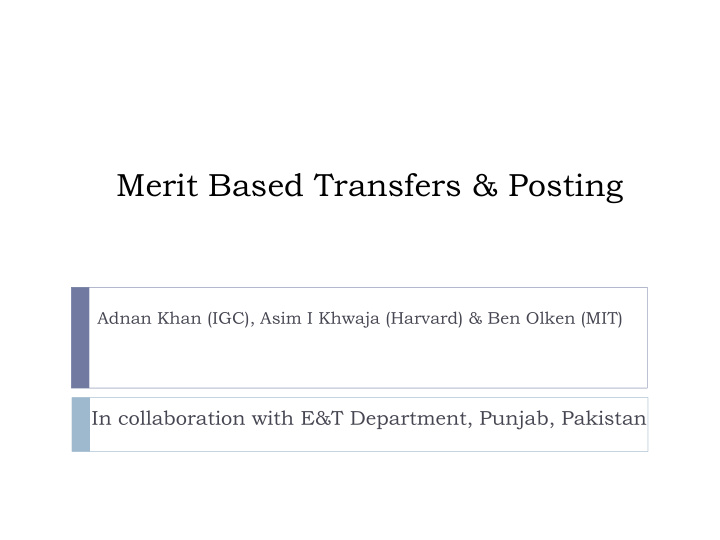



Merit Based Transfers & Posting Adnan Khan (IGC), Asim I Khwaja (Harvard) & Ben Olken (MIT) In collaboration with E&T Department, Punjab, Pakistan
Previous Project Recall: Success of Performance Pay Project (2011-13) Revenue Scheme – 46% increase in revenue in two years compared 28% for business as usual (comparison) group; RO: 33-50% Little Political Costs (no detectable difference in assessment accuracy or taxpayer dissatisfaction)
But Optimal HR policy is often both pecuniary AND non- pecuniary incentive mechanisms What could non-pecuniary benefits be in this context? Promotion (Yes – but limited opportunities) Social recognition (Yes – but not clear how this dilutes over time) Non-monetizable benefits (Yes – but not always systematically available) Transfers & Posting Lots of room (frequent movements) Tax-circles quite different (location; size – largest 50 times smallest) Desirable (tax staff care a lot about their postings)
Several Challenges in introducing a Merit-Based Transfers & Posting System Design Challenges: Measuring performance objectively Relative comparisons – how to define feasible comparison groups Large good because allows adjusting for noise/gives more choice But large makes it less feasible/puts more hardship on people; may also dilute “tournament based incentives” Administrative/Political: Transfers often based on administrative considerations Political highly sensitive Finance: Easy – No need for direct payments
Merit-Based Transfers & Posting System Scheme: – Make groups (of ten) circles Inspectors face performance tournament within group By end of year choose circle within group in order of performance rank July 2013 Pilot (to establish credibility): – Two groups of ten circles (two different city) Ranked on past performance Implemented all transfers successfully
Merit-Based Transfers & Posting System This Past Year 150 circles (groups of 10) – 15 groups of ten circles: Type A – rank on recovery Type B – rank on assessment value/tax base Why two types? One is more about flow (recovery) and the other is stock (tax base) - could have very different effects This past July Successfully made transfers for the 150 circles Around 60 transfers made (a few cases pending but should be done by end of month) – most have taken charge Greater fraction of people who move (60%) get better places Special Thanks to Director General and Secretary E&T !!
Merit-Based Transfers & Posting System Current Year (FY14-15) Of the 150 circles Half continue similar scheme next year – second chance (get to compare their choices to those who ended this year) Add another 70 circles to same scheme New Central Allocation scheme: Central allocation: Post people based on their abilities to specific circles (e.g., post “best” people in largest? fastest growing? greatest potential?) Design being finalized with department Two big questions we hope to be able answer Can Merit-Based T&P be an effective and feasible way to I. incentivize How best to allocate staff? II.
Recommend
More recommend